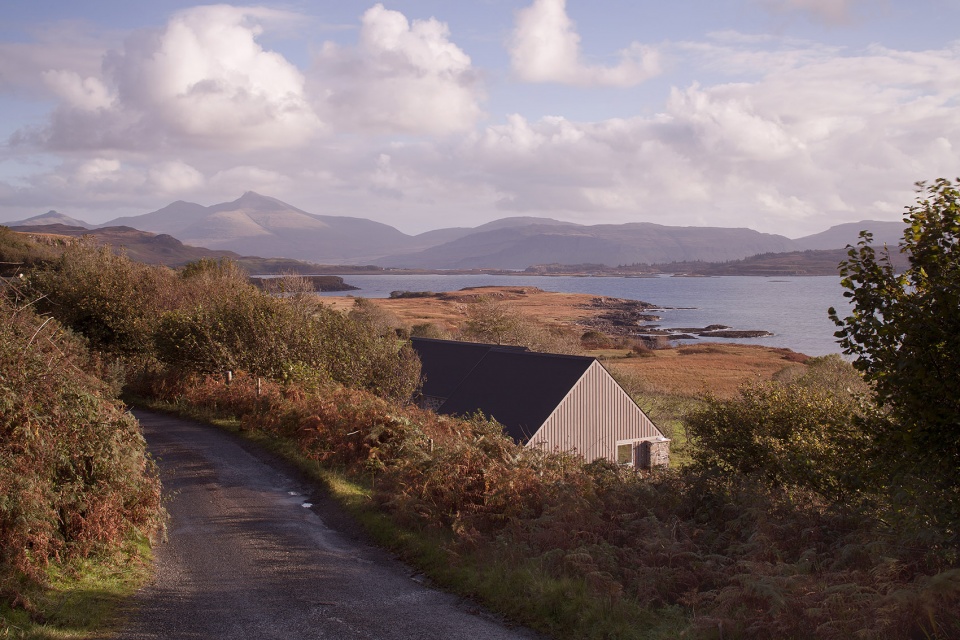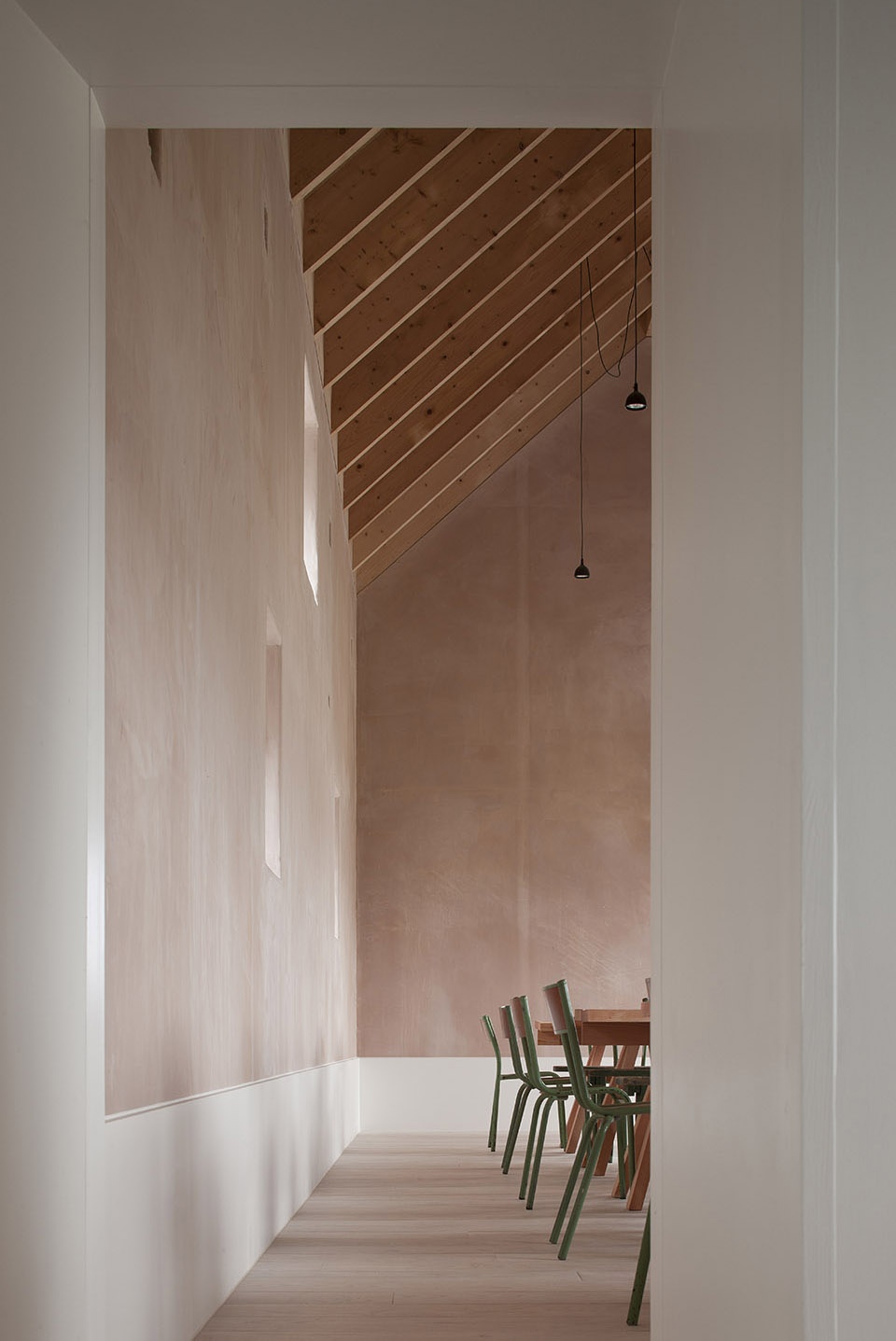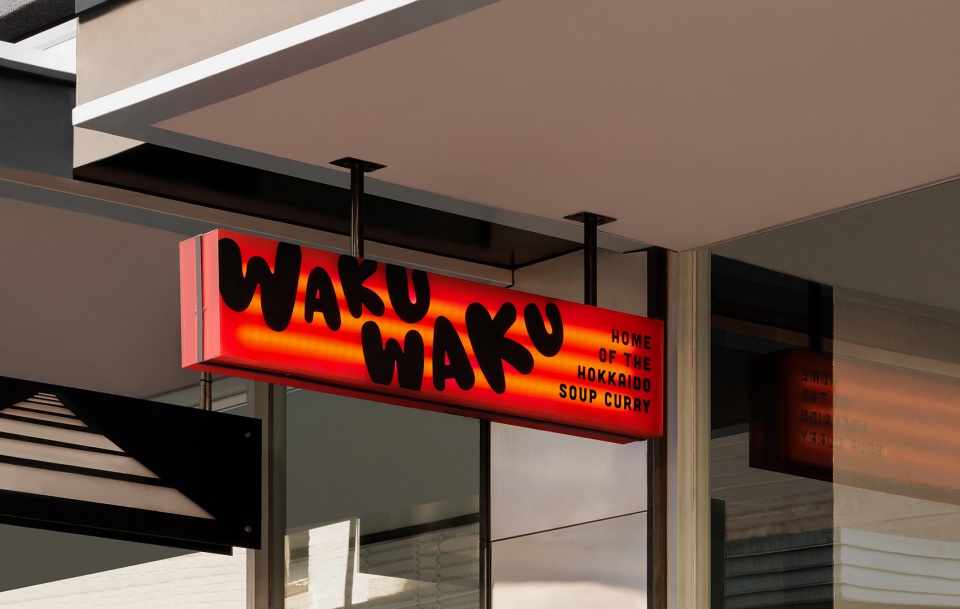

来自伦敦的建筑事务所fardaa将一座废弃的玄武岩谷仓创造性地改造成一处社区食堂和餐厅,为沿海社区提供了宝贵的公共资源。作为该事务所落成的首个项目,Croft 3社区餐厅的设计体现了建筑师对区位、经济、社会和环境负责的态度。
A ruined basalt barn has been creatively repurposed as a dining hall and restaurant by London-based fardaa, providing a valued community resource for a coastal community. Croft 3 marks the first completed project by fardaa and embodies the studio’s approach to place, economy of means, and social and environmental responsibility.
▼项目外观概览,overall of the project © David Barbour

Croft 3坐落于马尔岛(Isle of Mull)的海岸边,俯瞰着图斯湖(Loch Tuath)以及附近的Ulva岛。这些偏远的苏格兰岛屿以旅游业以及一家名为“Crofting”的小规模农场与当地社区紧密联系在一起。业主Jeanette Cutlack于2019年在该岛南部购买了一座废弃的Croft谷仓,以扩展她经营的当地家庭厨房式餐厅的规模。这家餐厅所烹制的所有肉类和鱼类制品都来自岛上,并是岛上唯一一家提供羊杂的餐厅。Jeanette计划重新利用这座废弃的croft谷仓,将这里改造为为当地提供新鲜肉类与蔬菜料理的餐厅。
Croft 3 is located on a coastal site on the Isle of Mull, overlooking nearby island, Ulva across Loch Tuath bay. The remote Scottish isles are characterised by close-knit communities supported by tourism and small-scale farming known as Crofting. Client Jeanette Cutlack purchased a disused Croft on the island’s South in 2019 to expand her busy local restaurant, which previously operated out of a home kitchen. The restaurant sources all meat and fish from the island, and makes the island’s only commercially available haggis. Jeanette has plans to bring the croft back into use to directly supply the restaurant with meat and vegetables.
▼由建筑看海湾,viewing the sea from Croft 3 © David Barbour


▼侧立面远观,viewing the profile at distance © David Barbour

这座破旧的石砌谷仓坐落在海边的斜坡上,经改造后的餐厅空间与一座由木材扩建出来的门厅、厨师厨房和游客设施相连。建筑的设计由两个偏移的坡屋顶体量定义,它们与横跨Ulva岛海湾的双山景观相呼应,两者之间相互依存又相互独立。两个体量的山墙对比鲜明,分别由石材与木材搭建,设计从当地建筑语言中汲取灵感,无论从哪个方向看,都展示出强而有力的存在感。
Set low into the sloping plot, the development sees the adaptive reuse of a dilapidated stone barn into a dining hall, connected to a new timber-clad extension housing foyer, chef’s kitchen and visitor facilities. Croft 3 is defined by two offset pitched volumes that echo the twin hillscape of Ulva across the bay, designed so neither is subservient to the other. The contrasting gables – one of stone, one of timber – take their cues from the local vernacular and offer a strong profile regardless of the direction of approach.
▼谷仓山墙,gable of the barn © David Barbour

▼扩建部分山墙细部,details of the gable © David Barbour

▼立面细部,details of the facade © David Barbour

游客们将从山坡上方以及谷仓后侧的小路进入餐厅,长长的黑色屋顶看起来仿佛比远处的海岸线与Ulva岛还要低。由小路下至入口,人们将由低矮的私密门厅进入建筑,周围的景观也因此隐藏在视线之外。穿过门厅后,高大明亮的走廊将空间变得豁然开朗,再次转弯穿过一扇深深的门廊后,就来到了主要餐厅空间,这里享有远处大海、海湾和岛屿的壮观景色。这样的空间序列与交通流线,旨在将室内的尺度与宏伟的环境分离开来,以提升空间的美感以及与景观的联系。
Visitors approach the restaurant from the road above and behind, the long black roofs of the building appearing lower than the sea and Ulva beyond. Descending to the entrance, the landscape becomes hidden from view as the building is accessed via a low, intimate foyer. From there one turns into a tall, light hallway, before turning again, through a deep compressed doorway and into a grand dining-room with spectacular views of the sea, bay and islands beyond. This sequence of approach and entry is designed to heighten the sense of space and connection to the landscape beyond by first disassociating visitors with the scale and grandeur of the setting.
▼入口玄关,entrance © David Barbour

▼通往餐厅的走廊,doorway to the dining hall © David Barbour

▼通道细部,details of the door way © David Barbour


现有的结构都已经用石灰砂浆和从原来的石砌结构中回收的玄武岩进行了修复。由松木椽子和胶合板构成的木材天花板裸露在空间中,为高大的开放空间增添了柔和温暖的质感。为了创造舒适的体感环境,建筑师为厚厚的建筑围护结构增添了新的开口,而窗与门则被设置在洞口的远端,进而在保留原始开窗布局的同时,将全新的门窗与外立面齐平,将谷仓的原始形式以全新的建筑语言表达了出来。
The existing structure has been restored using lime mortar and salvaged basalt from the original stone structure. Overhead, an exposed timber ceiling of pine rafters and plywood adds a gentle warmth to the tall, open space. Heavily insulated to reduce heat loss, the thick building envelope is punctuated by existing and new openings. Windows and doors are set deep in the wall for the original apertures, preserving the appearance of punched openings, whilst new windows are flush with the external face to trace the form of the original building.
▼大餐厅概览,interior of the dining hall © David Barbour

▼美国白灰木地板与柔和的鲑鱼色调生石膏墙相辅相成,
American White Ash timber floors complement soft salmon tones of raw plaster walls © David Barbour


Croft 3的室内空间由简单的原材料定义。在餐厅里,美国白灰木地板与柔和的鲑鱼色调生石膏墙相辅相成,低成本材料却为用餐空间创造出高品质的背景,同时能够捕捉光线并在一天中变化,为室内营造不同的氛围。高大的白色围板和门板与餐厅的色调形成对比,以坚固耐用的品质迎合了高客流区域的需求。餐厅中的法式咖啡椅和酿酒长凳均由回收而来,公共长餐桌则由岛上种植的道格拉斯冷杉制作而成。
Croft 3’s interiors are defined by simple, raw materials. In the dining hall, American White Ash timber floors complement soft salmon tones of raw plaster walls, a low cost textural dining backdrop that catches light and changes throughout the day. Tall, white painted skirting and door surrounds contrast with these more varied tones and provide robust surfaces in high traffic areas. The dining room is furnished with reclaimed french cafe chairs and brewers’ benches and long, communal dining tables made on the island from a single douglas fir.
▼由室内看Ulva岛海湾,viewing the Ulva Island Bay from interior © David Barbour

▼餐厅细部,details of the dining hall © David Barbour


▼新增窗口,new opening adding to the original wall © David Barbour



在木材覆盖的扩建部分的西南角和东北角,分别坐落着两座实心石墩作为新厨房和入口的锚点,这两处结构增强了扩建部分与现有石砌门廊的联系,并将石材的肌理进一步延伸到新的窗户、门和屋檐结构中。为了进一步突出周围环境的宏伟壮丽,由fardaa设计的Croft 3餐厅从传统岛屿农场紧密耦合的建筑体块中获得灵感,为餐厅内部创造出壮观的远景视野。餐厅于2022年10月完工,其设计彰显出这家年轻事务所对设计情境,以及可持续建筑的把控能力,同时体现出他们对社区和文化的关注与重视。
Two solid stone pylons at the south west and north east corners of the timber-clad extension act as anchors for the new kitchen and entrance, strengthening a datum relating to the existing stone doorway and further extending to new windows, doors and eaves. fardaa designed Croft 3 to enhance the grand setting, taking cues from the close-coupled massing of traditional island farmsteads, whilst opening up the interior to spectacular distant views. The dining hall was completed in October 2022, and highlights the new studio’s capability to design contextual, sustainable architecture that values and enhances community and culture.
▼入口外观,exterior view of the entrance © David Barbour

fardaa的创始董事Edward Farleigh-Dastmalchi说:“作为一家总部位于伦敦的事务所,我们很高兴有机会扩大我们的业务范围,为当地人和游客创造出新的文化联系,并为偏远的岛屿创造收入。在马尔岛这样崎岖的海岸环境中工作,既是一项挑战也是一次机会,让我们能够在这样美丽的新环境中,将我们对打造社区空间的热情付诸行动。”
Edward Farleigh-Dastmalchi, Founding Director of fardaa says; ‘As a London-based practice, we relished the opportunity to broaden our reach and contribute a new cultural connector that serves locals and visitors, with an added benefit of generating revenue on the remote island. Working in a rugged coastal setting such as the Isle of Mull was an opportunity to put our passion for crafting community spaces into action in a new and beautiful context.’
▼室内光影,light and shadow © David Barbour


Croft 3的所有者和经营者Jeanette Cutlack说:“我的梦想就是将croft重新投入使用,十年来,每当我走过这座谷仓时,都会想象山坡上的羊群和谷仓旁边生长的农作物。现在这个梦想已经成为现实,我可以在最华丽的空间里工作。Edward和我从十几岁起就是朋友了。我买下这座谷仓后,从没想过邀请别人来当建筑师。这是一个特殊的项目,我的父母在项目建造的过程中去世了,如果没有他们,我的梦想是不可能实现的。Croft 3社区餐厅促进了人们之间的联系,增强了人们的社区意识,这一点让我无比自豪。”
Jeanette Cutlack, Owner & operator of Croft 3 says; ‘Bringing the croft back into use is a dream come true. For ten years, I would walk past the barn and imagine sheep on the hillside and food growing next to the barn. Now that dream has become a reality and I get to work in the most gorgeous space. Ed and I have been friends since our teens. Once I bought the barn, it never occurred to me to ask anyone else to be the architect. This is a special project that would not have been possible without my parents who passed during the build. I am very proud to see Croft 3 reflect the sense of connectedness and community that allowed it to come to fruition.”
▼夜景,night view © David Barbour

▼区位图,location © fardaa

▼总平面图,master plan © fardaa

▼平面图,plan © fardaa

▼立面图,elevations © fardaa

▼山墙立面,profiles © fardaa













